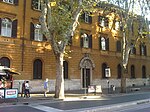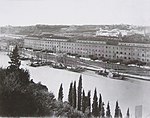Blessed Ludovica Albertoni
1670s sculptures1674 worksBaroque sculptureMarble sculptures in ItalySculptures by Gian Lorenzo Bernini ... and 1 more
Sculptures of women in Italy

Blessed Ludovica Albertoni (Italian: Beata Ludovica Albertoni) is a funerary monument by the Italian Baroque artist Gian Lorenzo Bernini. The Trastevere sculpture is located in the specially designed Altieri Chapel in the Church of San Francesco a Ripa in Rome, Italy. Bernini started the project in 1671, but his work on two other major works—The Tomb of Pope Alexander VII and the Altar of the Blessed Sacrament in St. Peter's Basilica—delayed his work on the funerary monument. Bernini completed the sculpture in 1674; it was installed by 31 August 1674.
Excerpt from the Wikipedia article Blessed Ludovica Albertoni (License: CC BY-SA 3.0, Authors, Images).Blessed Ludovica Albertoni
Piazza San Francesco d'Assisi, Rome Municipio Roma I
Geographical coordinates (GPS) Address Website Nearby Places Show on map
Geographical coordinates (GPS)
| Latitude | Longitude |
|---|---|
| N 41.8847 ° | E 12.4728 ° |
Address
San Francesco a Ripa
Piazza San Francesco d'Assisi
00153 Rome, Municipio Roma I
Lazio, Italy
Open on Google Maps










